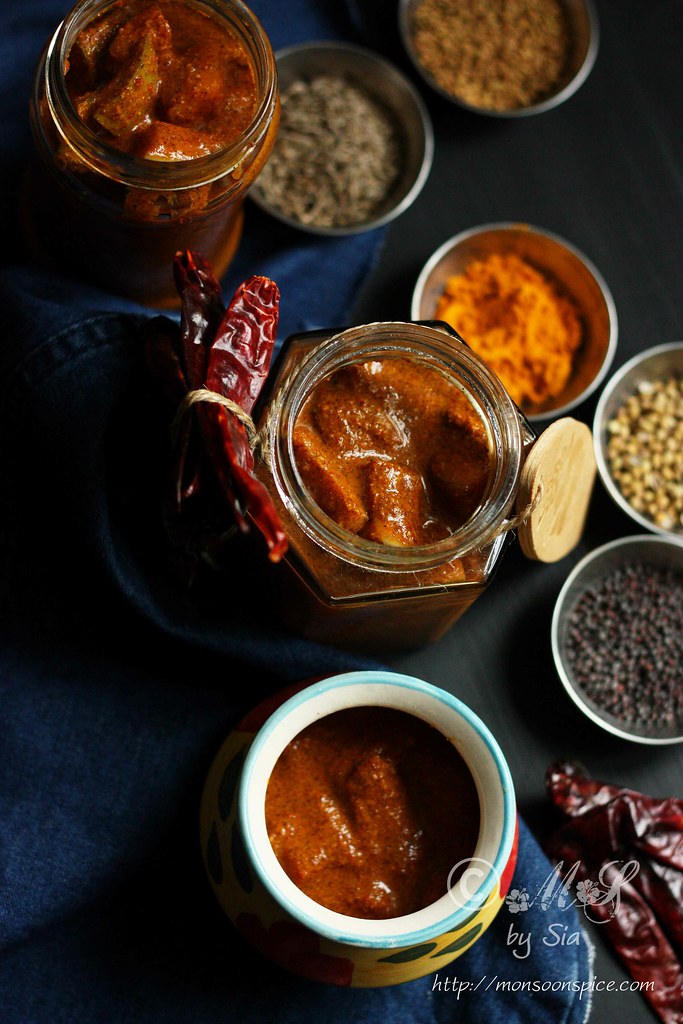
Learn how to make Spicy Cut Mango Pickle ~ No Oil Spicy Raw Mango Pickle Recipe
Family recipes, the recipes that have been cooked for decades and some even for centuries are the most treasured ones and close to my heart. Our taste, preference and choice change with time, but certain recipes withstand the test of time as they tie us to our roots and happy memories. Recipes like these need to be treasured, preserved and cherished for honoring the previous generations and for the new generations who are yet to sample the goodness of life!

No Oil Mango Pickle Recipe
To us Indians nothing says ‘home’ in simple reassuring words as pickle. No Indian meal is complete without a smidgen of pickle adoring the thali or plate. Whichever part of the country you come from, pickle is most likely to be the part of your earliest food memories as an important and incentive part of your meal to make staid combination of dal and rice seems more appetising or adding zing to any boring meal. Spicy, sour, sweet, astringent or salty, pickle is one thing that has the power to awaken our taste buds and memories of hot summer days spent in the company of my grandmother, mother, and loving aunts in the palatial home kitchen who lovingly filled dozens of large ceramic jars with pickles of different kinds.

Spicy Cut Mango Pickle ~ My family’s secret pickle recipe that is tested and treasured for over 100 years!
Pickling is almost like a sacred ritual which needs patience, devotion and love. The summer season, the season of pickles, the whole household got busy with choosing the ingredients for the pickle. Everyone worked together as a team in the courtyard open kitchen to get away from the heat of large home kitchen. My grandma took in charge of the whole pickle affair and under her hawk like eyes, every other person got busy with the task assigned to them. The most favourite and most picked fruit was the tender raw mango which was pickled as a whole called ‘maavina midi uppinakaayi’ or cut into small pieces known as ‘tundu or kette uppinakaayi’. After mango there was jars of ambate kayi (hog plums), nellikayi (amla or Indian gooseberry), karande kayi (sour plums), and nimbe uppinakaayi (lime).
The mangoes for the pickle came from the family’s mango orchard which was picked by the experts by climbing the tall trees and picking them by hands. My grandma never used the mangoes that fell on ground as she believed they don’t last for a very long time when pickled. The mangoes used were quite sour, tender, parrot beaked ones with high astringent tasting sap or milky juice that comes after breaking the stalks. As one member of the family got busy with separating the stalks from the tender mangoes, other worked on cleaning and drying the large ceramic jars designed for pickling.
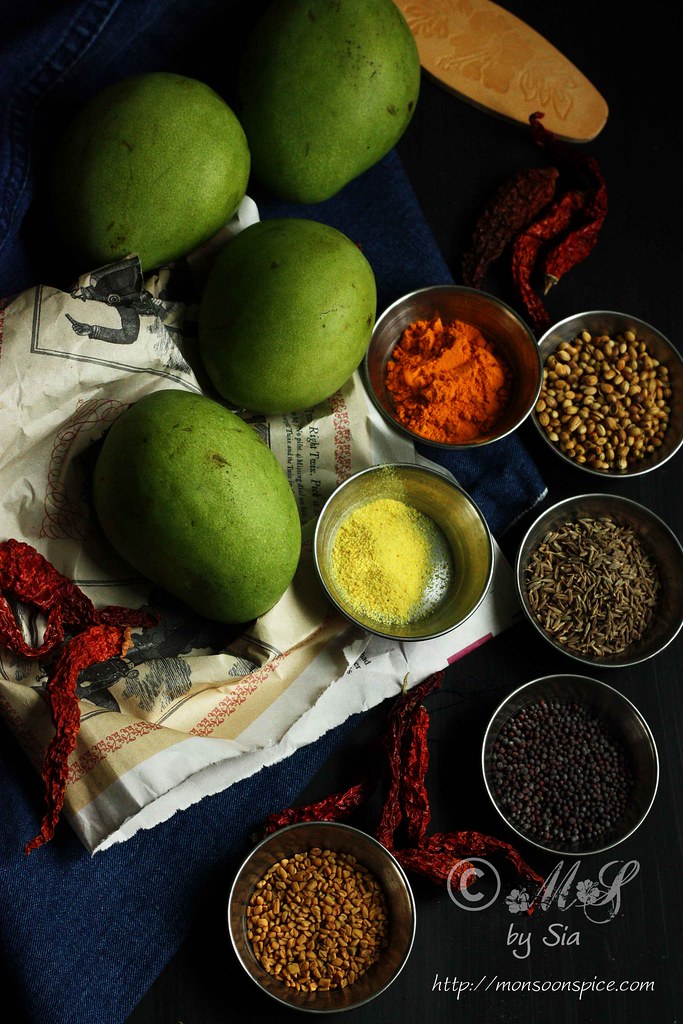
Ingredients for Spicy Cut Mango Pickle
As our family preferred the whole tender mango pickle, more than half the mangoes were used up in making whole mango pickles. All the pickle made had no oil in them and hence it was very important to use right quantity of sea salt as a preserving agent. These whole mangoes were stored in jars of brine made by boiling the high salted water and cooling it to room temperature before storing. The jars were kept aside in a dark, cool attic for a month so that the mangoes absorbed enough salt water and their skin wrinkled up. The rest of the mangoes were cut into bite sized pieces are pickled directly or used in making ‘beyisida kette uppinakayi’ or simply cooked mango pickle.
The freshest spices were picked, measured and roasted separately in a large kadai on a lowest heat, stirring till they were roasted and released their heady aroma that made one dizzy with excitement. One has to enjoy this therapeutic process, can’t rush to as in a hurry to reach the fish line in a running race. As one of the women at home roasted the spices in an open fire wood fuelled stove, others begin to pound the roasted and cooled spices in a stone grinder. The sight was pure magical for us little one who couldn’t stay away from the hustle and bustle of kitchen for very long time. The colour, the sight, aroma, and the whole process was pure magic to us little ones who were fortunate to be the part of this food memory with three generations before us working together a happy team in creating something that will leaving a lasting impression in all our lives!
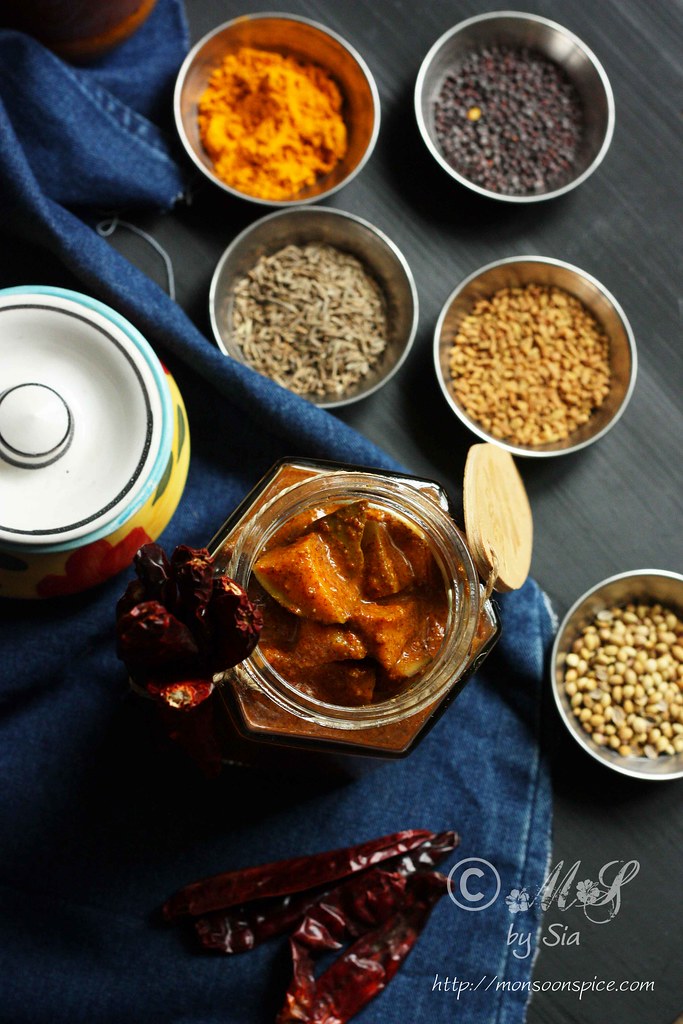
Spicy Cut Mango Pickle ~ No oil mango pickle recipe
With busy life that we lead in 21st century, traditional pickles are fast disappearing as we depend on store-bought pickles for the convenience. But with so much of our culinary history at stake, it is worth every penny to forsake the shortcut methods of store bought convenience for the time consuming and painstaking, yet most rewarding experience of making our own pickles at home. Because in the end you are not just preserving the fruits or vegetables, but preserving memories, family recipes and the taste of home!
Today I am sharing one such secret family recipe that is tested and treasured for over 100 years! This is my mother’s version of Spicy Cut Mango Pickle which is handed over by her grandmother and my great grandmother. This year I am taking a major step forward in making my own batch of pickles at home instead of depending on huge supply of homemade pickles from my Amma and Atte! :) Armed with the family recipe, I followed the recipe to T which is very unlike me, and made a small batch of this Spicy No Oil Mango Pickle few weeks ago. This is a no oil pickle and thus the preserving agent is salt. The technique is nothing like traditional pickle as the mango pieces are stored in brine for a day with a weight on top to drain excess water from it and then cooked for a short time in boiling salted water before drying them. Once dried, they are mixed in a spicy and very aromatic pickle mixture to enjoy year round.
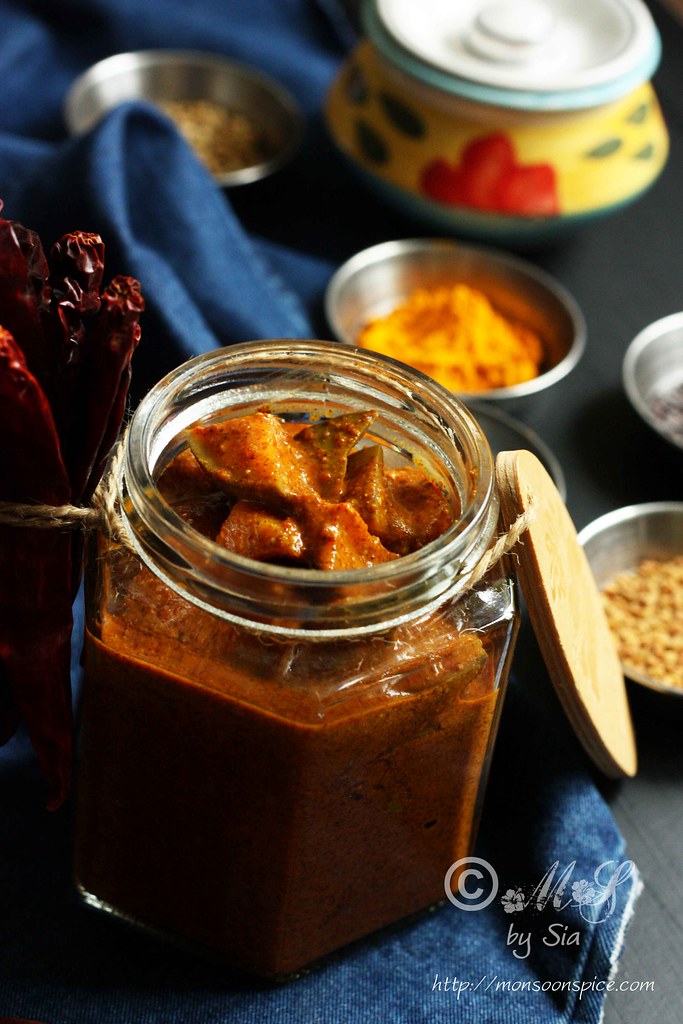
Cut Mango Pickle Recipe ~ From our family kitchen to yours!
The whole pickle making process is carried over 2 days. On day one, you prepare the mangoes, the salt water for the pickle sauce as well as roast the individual spices for the pickle masala. On day two, you proceed to cook the mangoes and then finish the whole pickling process. There are few key points you need to remember when making this Spicy Cut Mango Pickle. Please make sure all the utensils, spoons and ladles, knife and cutting board and storage jars are dry and moisture free as any moisture content will reduce the life of pickle.
Every time I assign myself with a task of preparing spice powders, I make sure that I have enough time on hand as the whole process of roasting the spices is not short of experiencing some magical and sacred! When it comes to roasting the spices, make sure that they are roasted on a lowest flame till their colour deepens and their perfume spread in my kitchen and teases your senses. This roasting spice is very sacred and something that cannot be rushed as spices are just like small children and they need your constant attention. If you get distracted or take your eyes away for a moment, they will burn and turn bitter and ruin the taste. So make sure that you have enough time on hand when you dive into the task of preparing this Spicy Cut Mango Pickle as it is a pure joy to all five senses! So are you ready to make your own batch of this No Oil Mango Pickle? Here is my family’s secret recipe for No Oil Spicy Mango Pickle, straight from my Amma’s large family recipe repertoire.

Raw mangoes for pickling

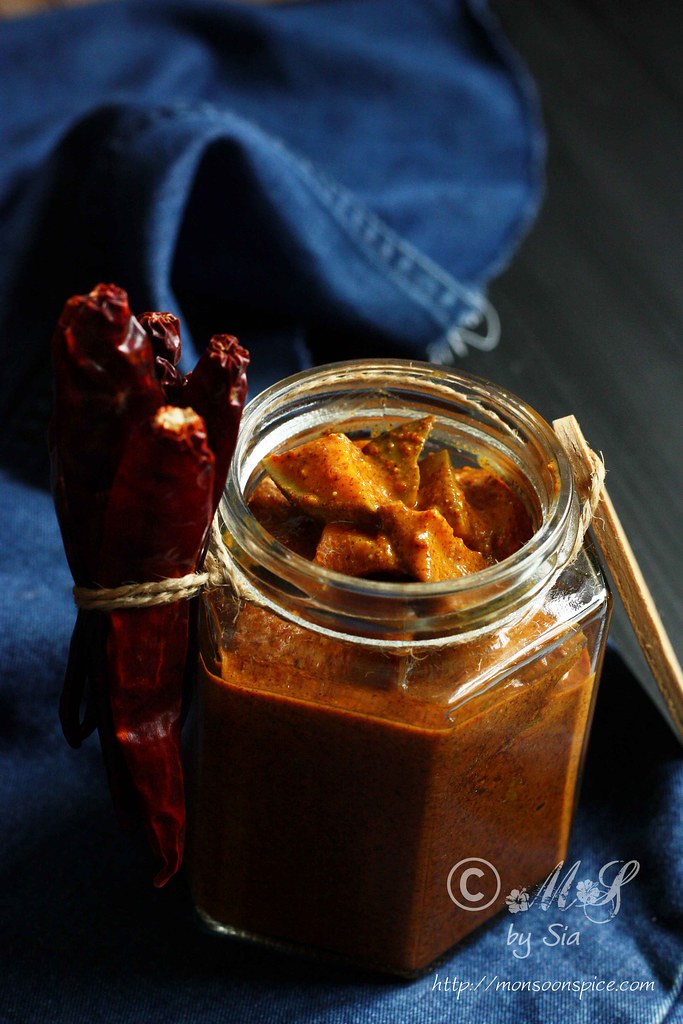
No Oil Spicy Raw Mango Pickle Recipe
No Oil Spicy Cut Mango Pickle (No oil mango pickle with homemade pickle masala)
Prep Time: 20 mins
Cooking Time: 30-40 mins
Resting Time: 2 days
Recipe Level: Intermediate
Spice Level: High
Makes: Around 4 cups
Recipe Source: My Amma
Shelf Life: 4 months at room temperature and 8-10 months in fridge
Serving Suggestion: With rice, dosa or Idli
Ingredients:
4 medium Raw Mangoes (About 2½ cups)
22-24 Dried Red Chillies (read notes)
½ cup Mustard Seeds
2 tbsp Dhania/Coriander Seeds
1 tbsp Jeera/Cumin Seeds
1 tbsp Methi/Fenugreek Seeds
10-12 Black Peppercorns
1 inch Dried Turmeric Root or 1 tsp Haldi/Turmeric Powder
1 tsp Hing/Asafoetida
1½ - 1¾ cups Salt, divided
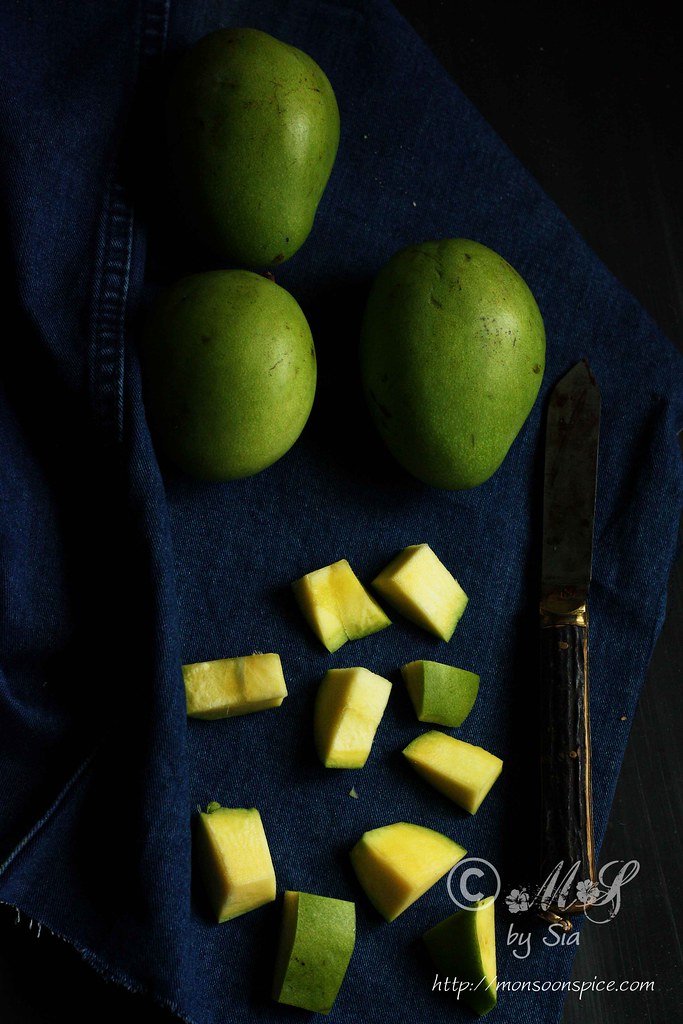
Day 1 ~ Wash and towel dry all the mangoes
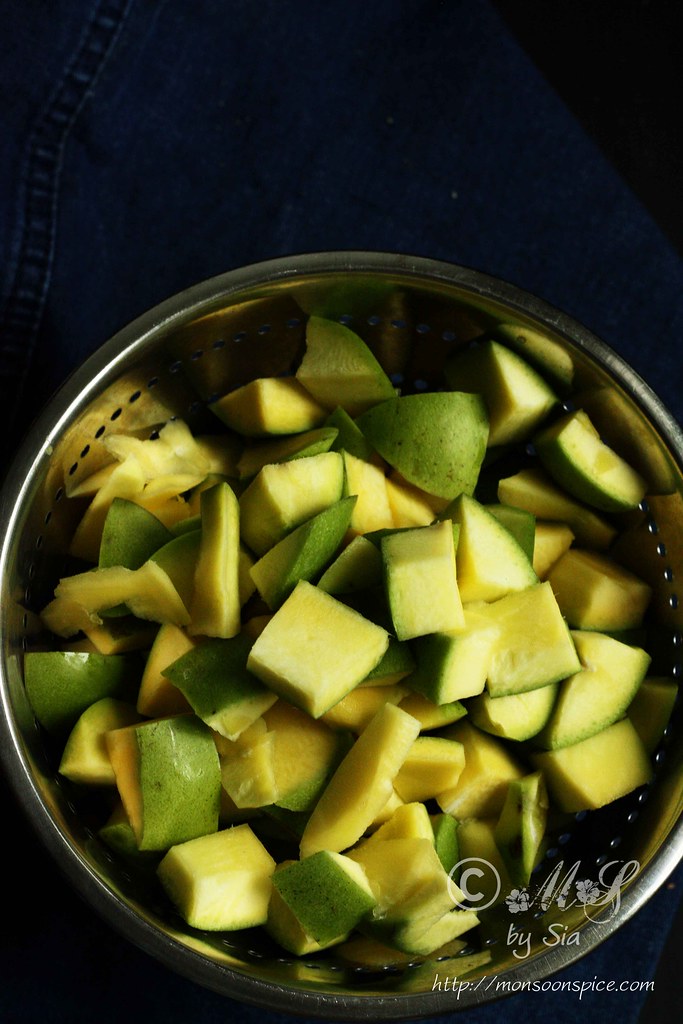
Day 1 ~ Cut the mangoes to bite size pieces

Day 1 ~ Mix salt to the cut mango pieces and keep them in a dry place by placing heavy material weighing down

Day 1 ~ Roast individual spices separately for pickle powder
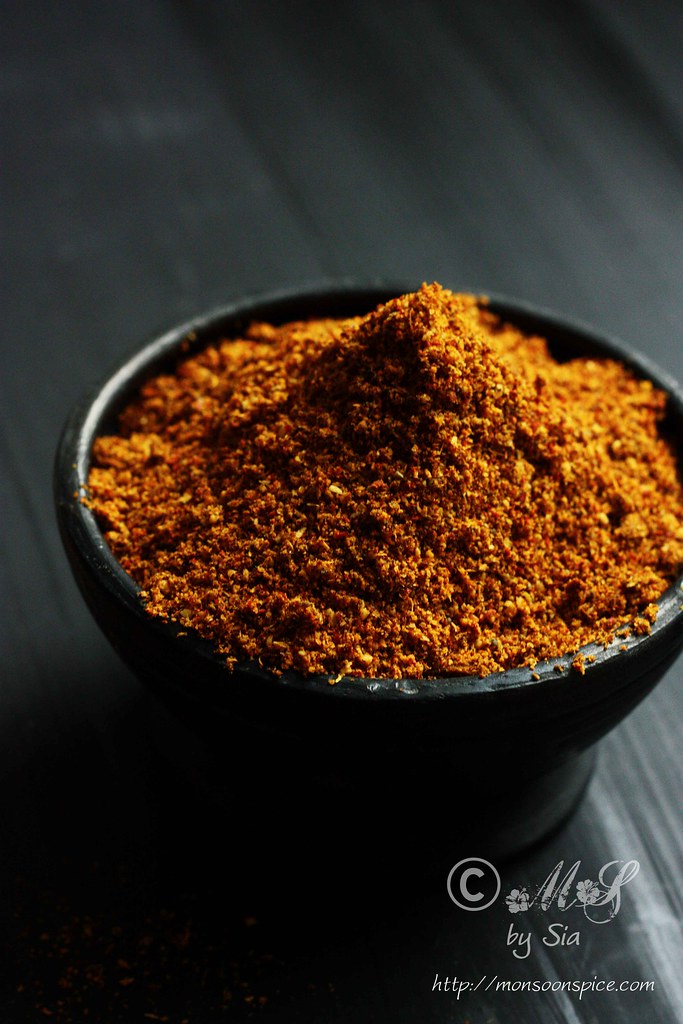
Day 1 ~ Grind the roasted spices and store it in an air tight container

Day 1 ~ Prepare the salt water for pickle paste
Method:
Day 1:
- First let’s start the pickle making by preparing the mangoes. Wash the mangoes and pat them dry making sure there is no moisture left. Any little moisture will reduce the lifetime of a pickle and it is important to make sure there is none. Once the mangoes are dried, cut them into bite size pieces. Scrape out all the mango flesh or pulp and discard the stone.
- Take two steel vessels, one large and another bit smaller one so that it fits inside the large one. Make sure that they are dry without any moisture content in them. Place the mango pieces in the large vessel and add about 2 heaped tbsp of salt. Mix them well with a help of a clean and dry spoon. Next place the smaller steel vessel on top and place any heavy material like stone pestle and mortar on top (please refer the photograph above to get idea). Keep it aside in a dry place overnight or preferably for 24 hours.
- Next, start to prepare the spices for pickle powder. Heat the pan, or in my case it is my trusted old cast iron skillet, on low flame until it is hot to touch. Dry roast coriander seeds, and cumin seeds, separately one at a time on low flame till their colour deepens and their perfume spreads through the kitchen. Similarly dry roast the mustard seeds until they pop and crackle. Make sure that you don’t burn any spices as they will make the pickle taste bitter! Keep them aside in a large plate to cool down to room temperature.
- Heat about 1 tsp of oil in a same pan and add dried turmeric root if using. Fry it on low flame until it plumps up, about 1 minute and keep it aside to cool down. Skip this, if using turmeric powder. In same oil, roast the fenugreek seeds and hing until the methi seeds changes colour to golden brown. Take care not to burn the methi seeds as it will taste bitter if roasted for too long. Keep them aside along with other roasted spices to cool down to room temperature. Next add 1 tsp of oil in a same pan and roast the dry red chillies on low flame until they plump up, about 1-1½ minute. Set them aside to cool down.
- While spices are cooling, proceed to make boiled salt water which will be used in making pickle sauce by mixing with pickling spice powder. Take 3- 3½ cups of water in a pan and mix in 1 – 1¼ cups of salt to it. Bring this salted water to roaring boil on a medium flame. Once the water comes to boil, simmer and let it boil for 2-3 minutes. Turn off the gas and let it cool down to room temperature. Cover and keep it aside until needed.
- Once the spices cool down to room temperature, place the roasted spices in a mixer grinder. First place the roasted chillies in the bottom, followed by other roasted spices for ease of grinding the spices. I use my trusted 8 years old sturdy heavy duty mixer grinder, but you can use the coffee grinder or spice grinder and grind the spices in batches. Don’t rush the grinding process of the spices for long time as the essential oils in the spice powder will release moisture contents and this moisture content will reduce the shelf life. So you grind the powders for short intervals, something like for 12-15 seconds, mix them gently with a help of a dry spoon to aerate and then grind them again for couple of seconds. Let the spice powder come to room temperature before storing them in an air tight container to be used on next day.
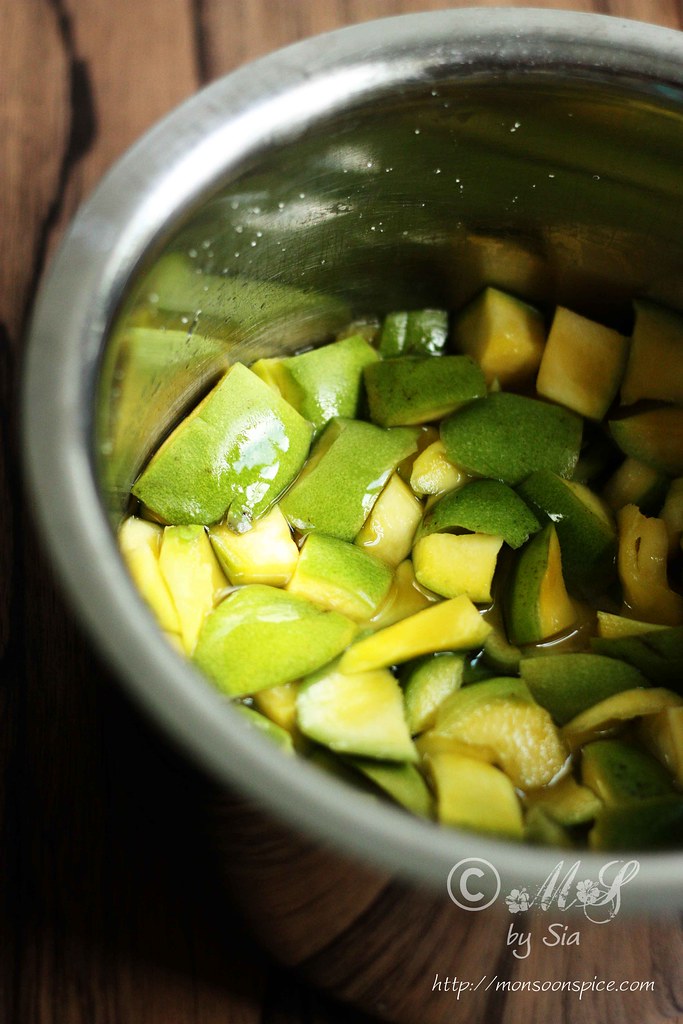
Day 2 ~ The juice/water is released from mangoes overnight and the cut mangoes are ready for pickling

Day 2 ~ Cook the mango pieces in salted water till their skin changes colour
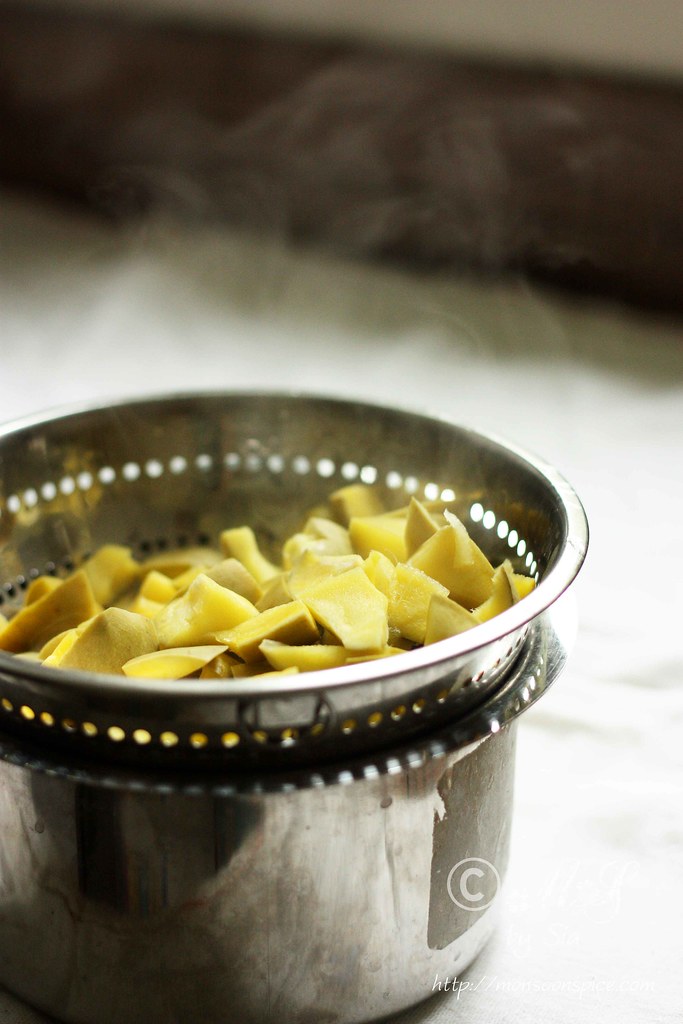
Day 2 ~ Drain all the water from cooked mango pieces. Note the change in their skin colour
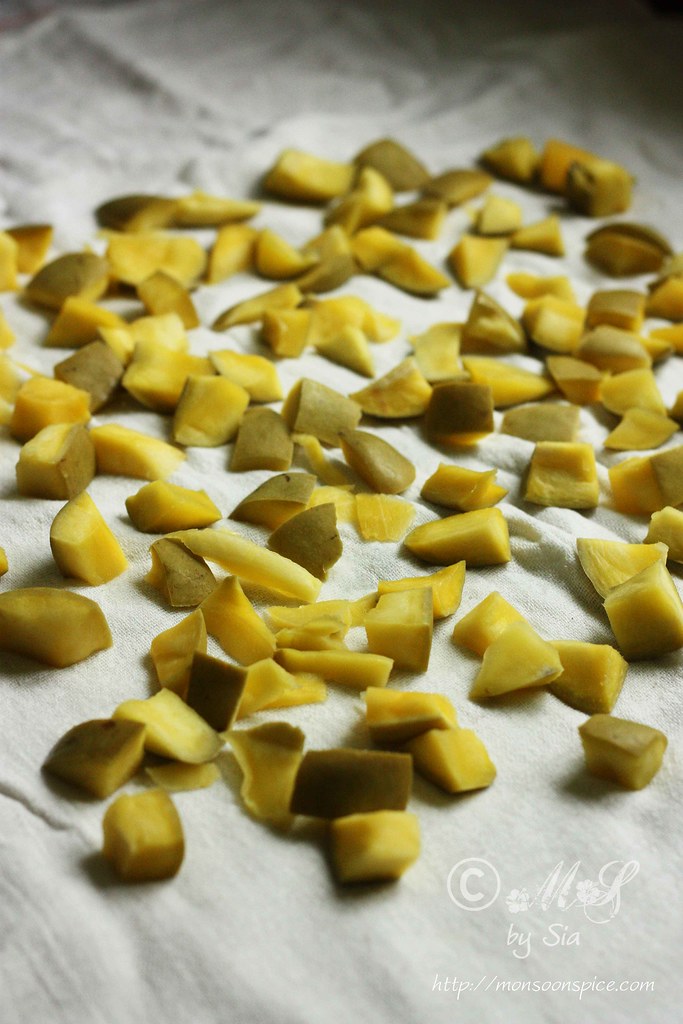
Day 2 ~ Spread them on a clean and dry cotton towel to cool them down to room temperature
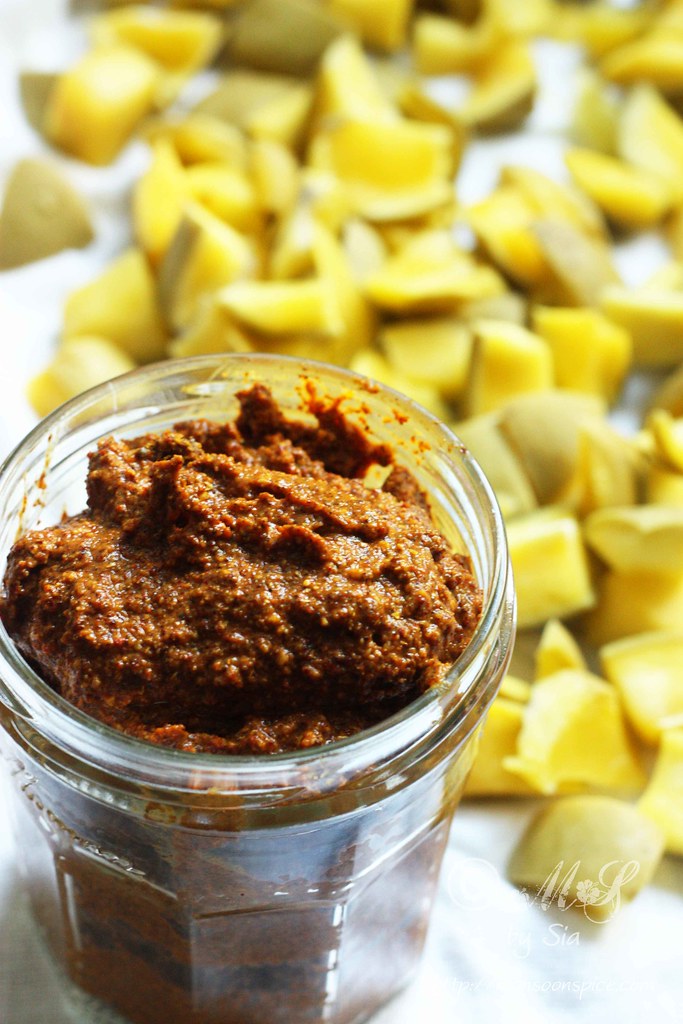
Day 2 ~ Prepare thick pickle paste by mixing salt water that you had made on previous day
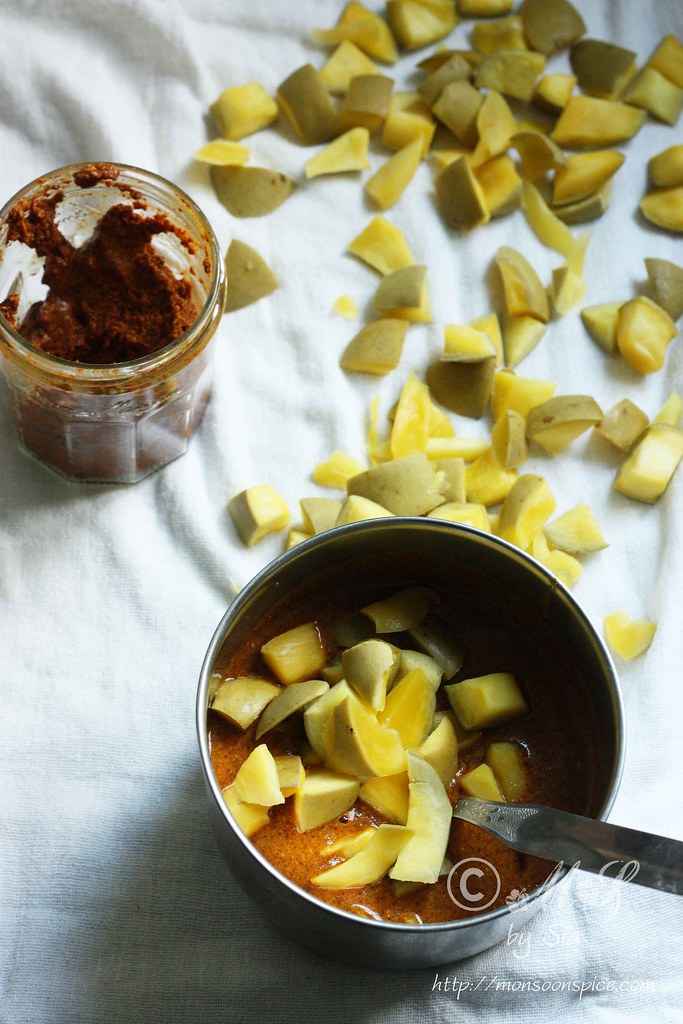
Day 2 ~ Save half of pickle paste and thin down the other half with salt water and mix it with a mango pieces to make pickle
Day 2:
- Next day you will find that the mangoes have released their water and they have shrunk in size little as they dehydrate. This was done in order to help the mango pieces absorb the spices from pickling sauce when mixed together. Drain the water released from the mango pieces and keep it aside.
- Add this mango juice to 3 cups of fresh water along with 2 tbsp of salt and bring it to boil. Once the water comes to boil, mix in mango pieces and reduce the heat to low. Let the mango pieces cook until their skin changes colour from deep green to yellow-ish green in colour as shown in the photograph above. It takes around 4-5 minutes and turn off the heat immediately.
- Place the mango pieces on a colander to remove all the water from it as shown in the photograph above. Once all the water is strained, spread the mango pieces on a clean cotton towel or kitchen towel and let it cool down completely.
- Next prepare the pickling sauce. Take the pickle powder in a dry mixing bowl and add cooled salted water that you had prepared on previous day. Add one cup of water at a time and mix them well until you get a pickling sauce of desired consistency. I make a fairly thick pickle paste and save half of it in an air tight jar for pickling next batch after few months. With the other half, mix enough salted water to make pickling sauce of pouring consistency, little thicker than buttermilk consistency. If there is still some more salt water is left after making the pickle sauce, you can save it in an air tight container for months and use it when needed.
- Once the pickle sauce is ready, add cooled mango pieces and mix them well. Add more pickling paste if needed from the saved half of pickle paste. Store the Spicy Cut Mango Pickle in an air tight container. You can serve it immediately with rice, dosa or idli, but it tastes better after resting for a week when the mango pieces absorb all the flavours and flavours blend well.

Spicy Cut Mango Pickle ~ No Oil Spicy Raw Mango Pickle Recipe
Sia’s Notes:
- The whole pickle making process is carried over 2 days. On day one, you prepare the mangoes, the salt water for the pickle sauce as well as roast the individual spices for the pickle masala. On day two, you proceed to cook the mangoes and then finish the whole pickling process.
- Please make sure all the utensils, spoons and ladles, knife and cutting board and storage jars are dry and moisture free as any moisture content will reduce the life of pickle.
- I have used mild flavoured Byadagi/Kashmiri Chilli for colour and spicy dry red chilli in 1:1 ratio.
- When it comes to roasting the spices, make sure that they are roasted on a lowest flame till their colour deepens and their perfume spread in my kitchen and teases your senses. This roasting spice is very sacred and something that cannot be rushed as spices are just like the small kids and they need your constant attention. If you get distracted or take your eyes away for a moment, they will burn and turn bitter and ruin the taste.
- While grind the roasted spices, first place the roasted chillies in the bottom, followed by other roasted spices for ease of grinding. I use my trusted 8 years old sturdy heavy duty mixer grinder, but you can use the coffee grinder or spice grinder and grind the spices in batches. Don’t rush the grinding process of the spices for long time as the essential oils in the spice powder will release moisture contents and this moisture content will reduce the shelf life. So you grind the powders for short intervals, something like for 12-15 seconds, mix them gently with a help of a dry spoon to aerate and then grind them again for couple of seconds.
- You can save half of the pickle paste in an air tight container and use it for making instant vegetable pickles. Similarly, store the leftover boiled and cooled salt water and use it to thin down the pickle paste. Both pickle paste and salt water can be saved up for six months.























Exquisite and perfect with some basmati rice!
ReplyDeleteCheers,
Rosa
mouth watering tempting mango pickle with awesome clicks.
ReplyDeleteYou sent my mouth watering, my memories racing and eyes treating with this pickle! Beautifully shot and so traditional. :)
ReplyDeleteHome made pickles are the best. Reminds me of my grand mom's jar of yumminess.
ReplyDeleteThank you all :)
ReplyDeletehi
ReplyDeletecan I make these pickles with oil
No, as this one is no-oil pickle!!!
Deleteok I want to know cumin and coriander powder does give taste to pickle can I use in oil mango pickles plz let me now
ReplyDeleteI am afraid I am unable to understand your query! Can you be more specific?
Delete